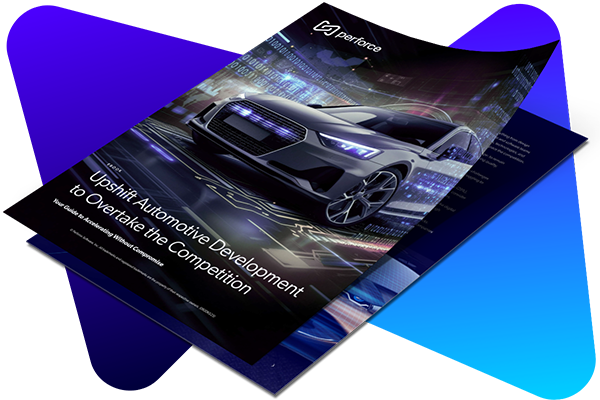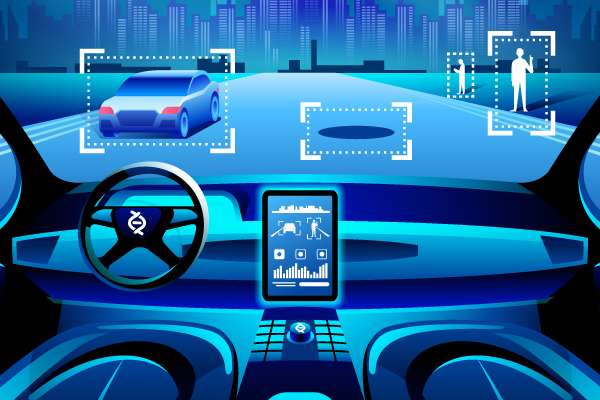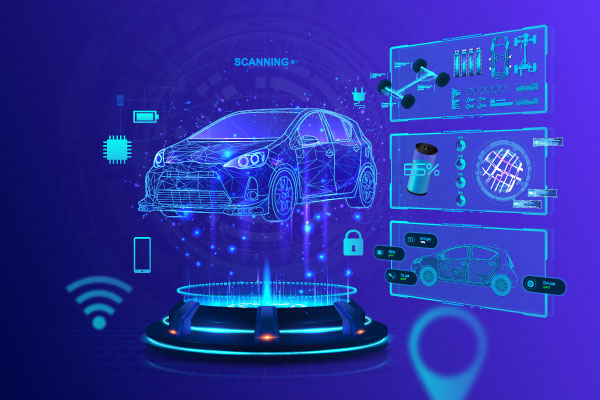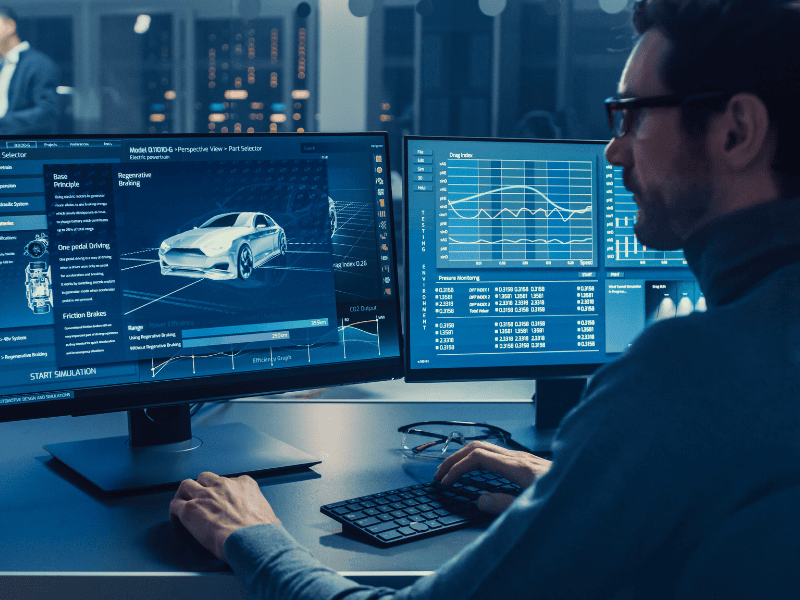Your Guide to Automotive Software Development
Modern vehicles increasingly rely on software for everything from infotainment to engine control and predictive maintenance. As the industry moves toward software defined vehicles (SDVs), automotive software architectures favor deeper software integration, flexibility, and continuous updates.
With modern vehicle software often exceeding 100 million lines of code, the automotive software development process can be complex and time-consuming. However, the right automotive software development tools, backed by industry best practices, ensure secure, reliable, and standard-compliant automotive software.
Below is a comprehensive information hub for automotive leaders and developers. Jump to the section most pertinent to your needs or scroll through to see a comprehensive library of resources outlining how Perforce solves today’s biggest development challenges.
Table of Contents
Automotive Software Development: Quick-Start
Critical-Safety Automotive Software Standards
Emerging Trends and Technologies Driving the Future of Automotive Software Development
Automotive Software Development: Quick-Start
There are many key factors to consider when developing automotive software to ensure it is safe, secure, reliable, and compliant with industry standards. Click on the resources below for a high-level look at the process:
Overview of Automotive Software Development
Our whitepaper covers automotive coding guidelines, ISO 26262 and other compliance standards, and quality safety metrics your team should monitor.
Essential Automotive Software Quality Metrics
This whitepaper takes a deep dive into the quality metrics necessary to meet most major compliance standards.
How to Develop Better Software in Cars—Faster
Get an overview of the current automotive trends and a breakdown of the key components of automotive software.
The State of Automotive Software
Read our annual report to learn where developers struggle and what the biggest challenges in the industry are.
Rev Up Your Automotive Software Dev
Watch the video to hear Director of Compliance Jill Britton and Product Director Steve Howard discuss notable trends and provide year-over-year comparisons from our automotive software report.
Inside the 2025 Automotive Software Report
What Holds Teams Back?: Want to learn how to overcome the challenges outlined in our automotive report? This blog has your answers.

Upshift Automotive Development to Overtake the Competition
Read this eBook to learn about the ins and outs of data management for automotive development. It includes five strategies for success.
Critical-Safety Automotive Software Standards
Complying with automotive software standards helps to ensure that your software is safe, secure, and reliable.
What Is ISO 26262?
ISO 26262 is the essential international functional safety standard for road vehicles. It’s a critical standard for automotive product development that ensures safety throughout the lifecycle of automotive equipment and systems.
A key part of ISO 26262 is the Automotive Safety Integrity Level (ASIL). ASILs are used to measure the risk of system components, with values A-D, where A is the minimum level of risk and D is the maximum. As the severity of risk increases, the compliance requirements get stricter.
What Is ISO 26262?
This blog gives a detailed explanation of ISO 26262 and how to meet compliance.
How to Comply with ISO 26262
This whitepaper provides in-depth strategies for meeting ISO 26262 compliance, including how to build a software platform with full traceability.
Perforce ALM Achieves ISO 26262 Certification
This blog explains our ISO 26262 certification for Perforce ALM and how it provides full traceability in your development work cycles.
Meeting ISO 26262 Standards: Data Management for Automotive Functional Safety
Learn how Perforce P4, an ISO 26262 certified data management platform, speeds development cycles without risking compliance.
MISRA®
MISRA provides a set of coding guidelines for safety-critical systems. Many safety-related development standards, like ISO 26262, recommend MISRA compliance.
What is MISRA?
This whitepaper provides an overview of MISRA and its guidelines around coding.
Comprehensive Guide to MISRA C and MISRA C++
We’ve created a content hub to answer all your MISRA-related coding questions.
Request a Custom QAC MISRA Compliance Module Demo
Our team demonstrates key features that help developers fix code early in the software development lifecycle and produce compliance reports for functional safety audits.
AUTOSAR
AUTOSAR standardizes the functionality of automotive embedded software. It helped to establish coding standards for C++, and shares coding rules with MISRA C++.
AUTOSAR Basics
Start with this whitepaper to understand the coding guidelines outlined by AUTOSTAR.

Motorcycle Standards
Motorcycle standards for functional safety have become essential with the growing number of electronic safety systems being developed for motorcycles. Learn about motorcycle safety integrity levels (MSILs) and how to comply with motorcycle functional safety standards.
UL 4600
The UL 4600 standard focuses on autonomous vehicles. The most obvious application is for self-driving cars, but its application extends to autonomous vehicles in agriculture and maintenance, as well as other vehicles such as unmanned aerial vehicles (UAVs).
How Does UL 4600 Keep Autonomous Trucking Systems Safe?
Learn how this important safety standard applies to driverless trucks.
Automotive Software Security
As vehicles become more connected and integrated with personal devices, it is essential that automotive software is designed with security in mind.
Automotive Cybersecurity 101
Automotive cybersecurity is an essential practice of software development as it helps to safeguard the software against security vulnerabilities. Learn which automotive cybersecurity best practices you should follow.
Automotive Cybersecurity
Get up to speed on the biggest cybersecurity vulnerabilities and learn how you can prevent them.
WP.29
WP.29 is an international automotive regulation by the United Nations Economic Commission for Europe (UNECE). It has adopted updates to address security concerns for automotive software development and vehicle manufacturing.
How to Enforce WP.29 Cybersecurity Guidelines
Our blog covers all of the regulations currently covered in WP .29.
The United Kingdom Automotive Cybersecurity Guidelines
Learn what automotive cybersecurity standards are unique to the United Kingdom.
What Are the UK’s Automotive Cybersecurity Guidelines?
We outline the eight principles for cybersecurity compliance in the UK.
Automotive Software Security with ISO 21434
ISO 21434 is an automotive standard that focuses on cybersecurity risks during the development and application of automotive software.
How to Keep Cybercrime's Foot Off The Pedal With ISO/SAE 21434
Emerging Trends and Technologies Driving the Future of Automotive Software Development
Automotive development is constantly evolving. Stay up to date on the latest advancements with these resources:

General Trends
Emerging Trends in Car Software Development
Where is automotive software headed? This blog explains.
AI
AI in Automotive Software Development
We break down some of the key discoveries regarding AI from our automotive software report.
Managing AI in Safety-Critical Systems
AI is transforming software development and offers many benefits — but it also introduces safety challenges due to non-deterministic behaviors. Download our eBook to learn about new functional safety standards, such as ISO 8800 for road vehicles, that help mitigate risk.

Software-Defined Vehicles
Why Code Quality Matters in Software Defined Vehicles
SDVs require strict code quality adherence. We explain why.
Autonomous, Connected, Electric, Shared (ACES)
ACES are more common than ever before. Follow our ACES resources to learn about the SOTIF (ISO 21448) autonomous driving standard, advanced driver assistance systems (ADAS), infotainment systems, and more.

